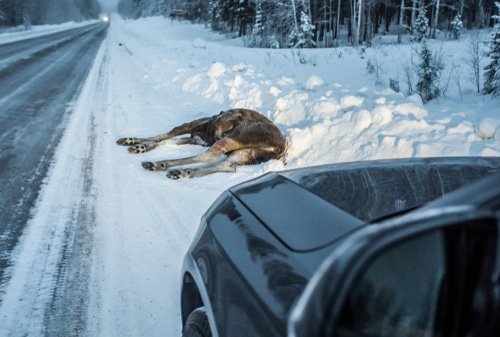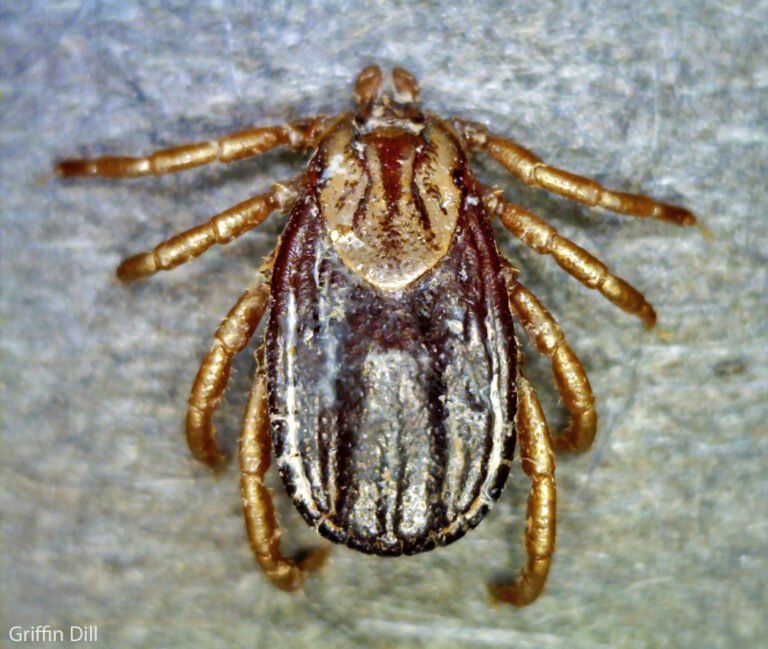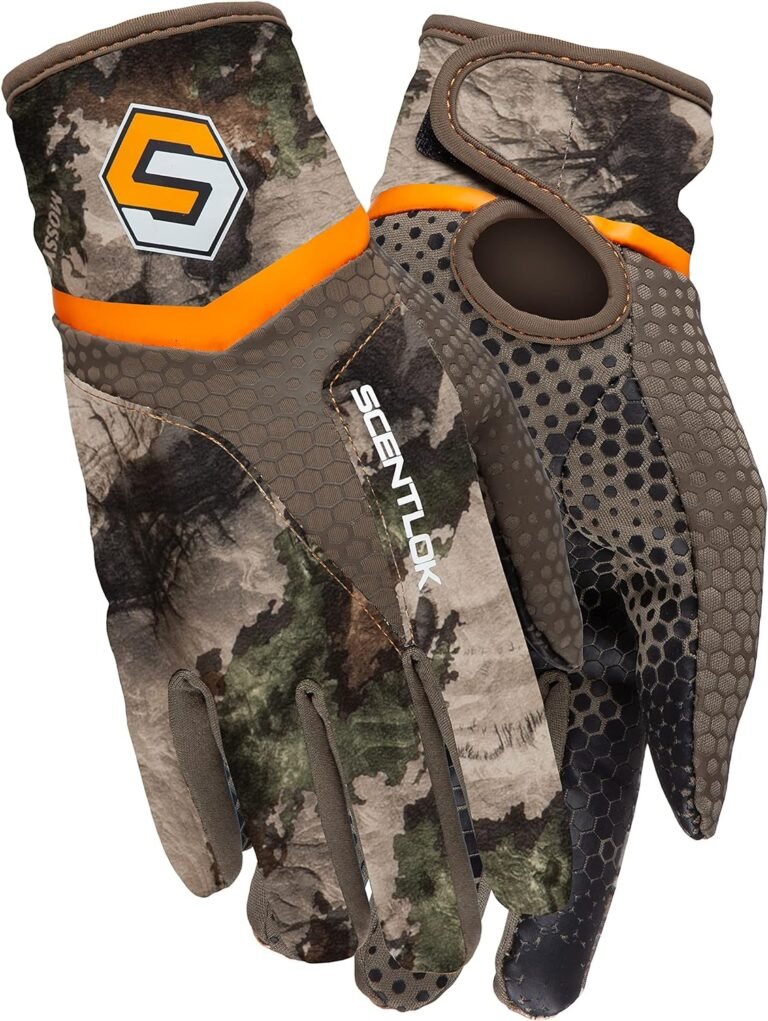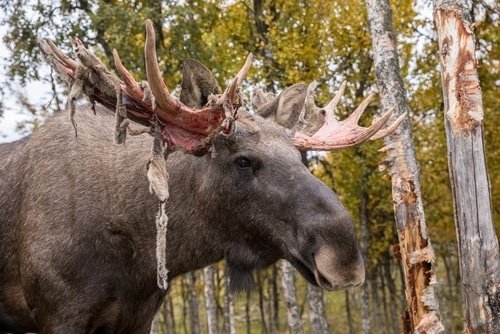When it comes to safety around moose, knowledge truly is power. These majestic creatures may appear gentle and calm, but don’t be fooled by their serene demeanor. Understanding moose behavior is crucial in ensuring your well-being when you find yourself in their habitat. In this blog, we will discuss moose safety tips to stay safe.
By familiarizing yourself with their habits and knowing how to react in different situations, you can greatly reduce the risks associated with encounters. This article aims to equip you with essential information on how to stay safe near these magnificent animals.
Overview of Moose Characteristics and Potential Dangers
Before we delve deeper into moose safety tips, let’s get acquainted with these remarkable creatures. Moose (Alces alces) are the largest members of the deer family, boasting impressive antlers that can span up to six feet wide! Standing tall at an average height of 6 to 7 feet at the shoulder and weighing between 800 and 1,600 pounds, they command respect and caution.
Despite their herbivorous diet primarily consisting of vegetation such as twigs, leaves, and aquatic plants, moose can exhibit aggressive behavior if they feel threatened or provoked. It’s important to recognize that while these animals are generally docile, certain circumstances or misinterpretations may lead them to act defensively or even charge at humans or other animals.
In the subsequent sections of this article, we will explore various strategies for preventing moose encounters altogether and understanding their behavior when interactions occur. Our shared knowledge and awareness can ensure a harmonious coexistence between humans and moose in their natural habitats.
Moose Encounter Prevention
Recognizing moose habitats and avoiding high-risk areas
When staying safe near moose, being aware of their preferred habitats is crucial. Moose are often found in areas with dense vegetation, such as forests, swamps, and marshes. They are especially fond of aquatic plants, so watch around lakes and rivers.
Moose also tend to frequent open meadows and shrubby areas where they can graze on grasses and shrubs. Avoid venturing into these habitats during outdoor outdoor adventures to minimize your chances of encountering a moose.
Time of day considerations for decreased likelihood of encounters
To maximize safety around moose, understanding their activity patterns is essential. Generally, moose are more active during the early morning or late evening hours when the temperatures are cooler.
If you prefer hiking or exploring nature trails, planning your outings for the middle of the day may reduce the likelihood of stumbling upon a moose unexpectedly. Additionally, remember that during hot summer days, moose might seek shade or cool off near bodies of water – another factor to consider when planning outdoor activities.
Proper disposal of food waste to minimize attraction
Moose have an incredible sense of smell and are naturally curious creatures. As such, they can be attracted to human food waste left behind at campsites or hiking trails. To prevent unwanted encounters with these majestic animals while camping or picnicking in their territories, ensure proper food waste disposal by using bear-proof containers or hanging food bags out of reach from tree branches.
Remember always to clean up after yourself – leaving no trace is respectful and beneficial for your safety. By watching for moose habitats and avoiding high-risk areas while considering their activity patterns, you can significantly decrease the chances of a moose encounter.
Additionally, practicing responsible waste disposal ensures that you don’t inadvertently attract moose to your vicinity. Remember, respecting their natural spaces and being mindful of their behaviors are key to enjoying nature while staying safe near these magnificent creatures.
Understanding Moose Behavior
Seasonal Variations in Moose Behavior
When understanding moose behavior, it’s crucial to consider the seasonal changes that influence their actions. One key aspect is the mating season, also known as the rut. During this time, typically in late September and early October, male moose become more territorial and can exhibit increased aggression.
They may engage in elaborate displays of dominance, including thrashing vegetation with their antlers and emitting loud grunts to attract females. It’s important to remember that moose are more likely to be on high alert and potentially unpredictable during the rut due to their heightened hormonal state.
Additionally, calving season—usually from May through June—is another period when moose behavior can change as females fiercely protect their newborn calves. Awareness of these seasonal variations helps us anticipate potential risks and adjust our approach to staying safe near moose.
Signs of Aggression or Distress in Moose
To ensure safety around moose, it’s essential to recognize signs of aggression or distress exhibited by these magnificent creatures. Understanding their body language can provide valuable insights into their emotional state.
If a moose feels threatened or uneasy, they may display warning behaviors such as stomping their front hooves on the ground or lowering their head with ears laid back. Raised feathers along the neck can also signify agitation.
Vocalizations play a significant role, too; a deep-throated grunt often indicates dominance or irritation, while a high-pitched whining sound suggests fear or stress. Observing these signs allows us to gauge whether we should keep our distance or strategically retreat.
Importance of Keeping a Safe Distance from Moose
One cardinal rule for staying safe near moose is maintaining a safe distance, even if they appear docile or nonchalant. These majestic animals may seem calm and peaceful, but they can swiftly turn aggressive if threatened or cornered.
Experts recommend maintaining a distance of at least 50 feet (15 meters) if not more, to minimize the risk of an unwanted encounter. Moose have long legs and powerful bodies, capable of delivering devastating kicks with their sharp hooves if provoked.
By respecting their personal space and avoiding any attempts to approach or feed them, we ensure our safety and the well-being of these incredible creatures in their natural habitat. Remember, it’s always better to admire moose from a safe distance rather than endangering ourselves or disrupting their behavior by getting too close.
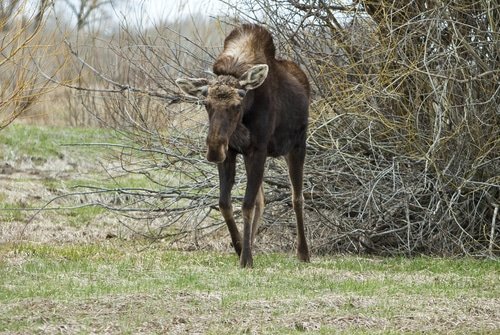
Maintaining a Calm Demeanor When Encountering a Moose
Imagine you’re out in the serene wilderness, surrounded by towering trees and the tranquil sounds of nature. Suddenly, you spot a majestic moose grazing in the distance.
Your heart skips a beat as you realize how close you are to these magnificent creatures. It’s crucial at this moment to remain calm and composed.
Moose are generally non-aggressive unless provoked or feel threatened. Approaching them with caution and respect will help ensure your safety around moose.
Strategies for Deterring an Approaching or Aggressive Moose
While maintaining composure is vital, there may be times when a moose decides to approach you out of curiosity or display aggressive behavior due to feeling threatened. In such situations, it’s essential to know how to deter them effectively. Making noise is one of the most effective ways to alert an approaching moose of your presence and hopefully discourage any further advance.
Clap your hands, stomp your feet, and shout loudly if needed. In more extreme cases where a moose becomes aggressive or charges towards you, having bear spray can be invaluable for self-defense.
Bear spray is specifically designed as a deterrent for large animals like bears and can also work on moose if used appropriately. Keep it accessible but remember that using bear spray should always be a last resort when all other attempts to deter the animal have failed.
Appropriate Actions When Encountering a Mother Moose with Calves
A mother moose with her adorable calves can melt anyone’s heart, but it’s crucial not to approach them too closely or interfere with their natural behavior. Mother mooses are highly protective of their young ones and won’t hesitate to defend them if they feel threatened. If you accidentally stumble upon a mother moose with her calves, it’s important to give them a wide berth.
Slowly and calmly retreat from the area while keeping an eye on the moose to ensure they don’t follow you. Remember, your intention is to admire these magnificent creatures from a safe distance without causing any harm or distress.
By maintaining your composure, knowing how to deter an approaching or aggressive moose, and respecting the boundaries of a mother moose with calves, you can ensure your safety around these fascinating animals. Remember, observing moose in their natural habitat is a privilege that comes with responsibility, so let’s do our part to coexist peacefully and harmoniously with these majestic creatures.
Vehicle Safety Around Moose
Tips for driving cautiously in areas with known moose populations
Driving through areas with known moose populations requires a heightened sense of caution to ensure your safety and that of the majestic creatures. First and foremost, it’s crucial to familiarize yourself with the specific locations where moose are frequently spotted. Local wildlife management agencies or park authorities can provide valuable information in this regard.
Additionally, stay attentive to any signage indicating high-risk areas. Keeping your eyes peeled for moose crossing signs and reducing your speed accordingly will give you more time to react if a moose unexpectedly appears.
The risk of collisions with moose on roads/highways
Collisions between vehicles and moose can have severe consequences, both for the individuals involved and for the beautiful animals themselves. It is essential to recognize that these accidents occur most frequently during dusk and dawn when visibility is reduced, making it challenging to spot a camouflaged moose on the road.
Therefore, during these particular hours, it’s wise to reduce your speed even further than usual and remain vigilant at all times. At night, when darkness engulfs the surroundings, driving near areas frequented by moose demands extra caution.
Slow down significantly, use high-beam headlights whenever possible (unless approaching traffic), and scan the area ahead diligently. Keep in mind that due to their tall stature, a collision with a moose poses significant risks as its body often ends up crashing through vehicle windshields.
Hiking/Camping Safety Among Moose Habitats
Choosing appropriate campsites away from known moose trails or feeding grounds
When planning outdoor adventures in regions where moose roam freely, it’s vital to select campsites wisely. Avoid setting up camp near known moose trails or feeding grounds as this may increase the chances of encountering a moose. Choose areas that provide ample distance from these paths, ensuring both your safety and the peaceful coexistence of wildlife with minimal disruption to their natural routines.
Proper food storage techniques to prevent attracting curious or hungry moose
To ensure a safe and enjoyable camping experience in moose habitats, it’s crucial to adopt proper food storage practices. Moose possess an incredible sense of smell and can be enticed by the scent of food from miles away.
Store your provisions in bear-resistant containers or hang them high above the ground between two trees, out of reach for even the tallest moose. Keeping your campsite clean and free of food scraps will also help deter any curious or hungry moose from venturing too close.
Lesser-Known Facts about Moose Behavior
The significance of antler size in determining dominance among male moose
Antlers are not merely magnificent ornaments adorning a male moose’s head; they play a crucial role in determining hierarchy within their population. The size, shape, and symmetry of antlers showcase an individual’s strength and dominance. During mating season, male moose engage in intense battles using their antlers to establish dominance over rivals and secure mating rights with females.
The role scent marking plays in communication among moose
Scent marking is an essential means through which moose communicate with one another. By urinating on vegetation or creating wallows (mud depressions), they leave behind distinctive scents that convey information about their age, sex, reproductive status, territory boundaries, and overall health condition. These olfactory signals enable effective communication between individuals without direct physical confrontation.
Conclusion
Maintaining safety around moose requires understanding their behavior patterns as well as implementing precautions while engaging in different activities near their habitats. Whether it’s driving cautiously, selecting appropriate campsites, or appreciating lesser-known facts about moose, our efforts can contribute to a harmonious coexistence with these magnificent creatures.
By respecting their space and taking necessary safety measures, we can enjoy the awe-inspiring presence of moose while ensuring their well-being and our own. So let’s remember to stay vigilant, be considerate of their needs, and embrace the wonders of nature responsibly.

